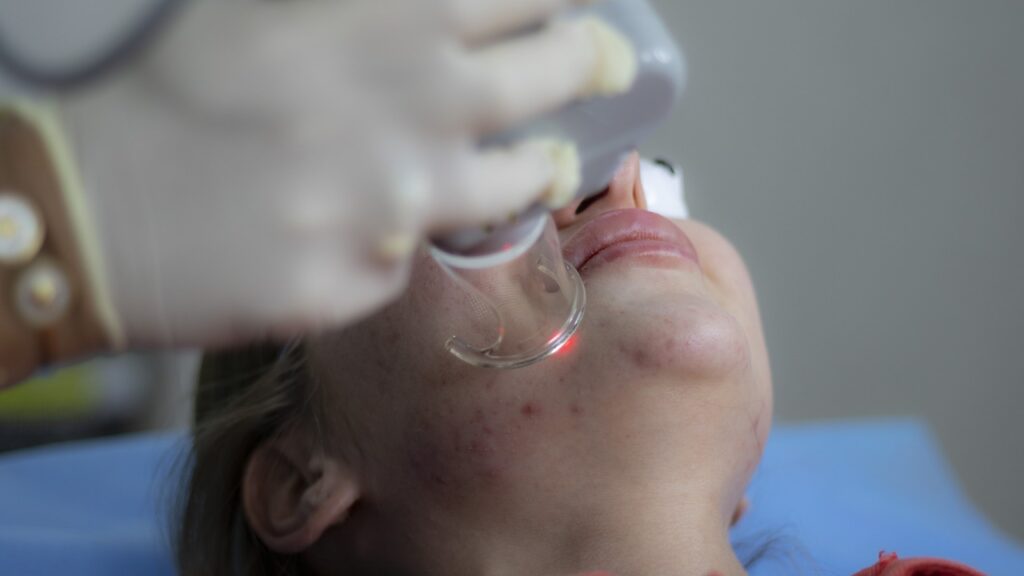
Are you tired of dealing with dark spots and uneven skin tone caused by hyperpigmentation? You’re not alone. Hyperpigmentation is a common skin concern that affects people of all ages and skin types. It occurs when there is an overproduction of melanin, the pigment responsible for giving our skin its color.
But don’t worry, there are ways to get rid of hyperpigmentation and achieve a more even complexion. In this blog post, we’ll discuss six expert-approved ways to treat hyperpigmentation effectively. From at-home remedies to professional treatments, we’ve got you covered. Let’s get to the list.
Table of Contents
Laser Treatment
Laser treatment is a popular and effective way to treat hyperpigmentation. It involves using targeted beams of light to break up the excess melanin in the affected areas of the skin. You can find hyperpigmentation laser treatment specifically designed for different skin tones and types, making it a safe and customizable option. This treatment can also help with other skin concerns such as acne scars and wrinkles.
However, it may require multiple sessions to see significant results, and there is a risk of potential side effects such as redness and swelling. It’s essential to consult with a dermatologist before opting for laser treatment and follow their aftercare instructions for the best results.
Chemical Peels
Chemical peels are another popular option for treating hyperpigmentation. This treatment involves applying a chemical solution to the skin, which causes the top layer to peel off, revealing smoother and more even-toned skin underneath. Chemical peels can vary in strength, with milder ones available for at-home use and stronger ones administered by a dermatologist.
It’s essential to note that chemical peels can cause temporary redness and irritation, so it’s best to avoid direct sun exposure after the treatment. Multiple sessions may be required to see significant results, and it’s crucial to follow a proper skincare routine recommended by your dermatologist after the treatment.
Microdermabrasion
Microdermabrasion is a non-invasive treatment that uses tiny crystals or a diamond-tipped wand to exfoliate the top layer of skin gently. This helps remove dead skin cells and stimulate collagen production, resulting in a brighter and more even complexion. It’s a safe and painless procedure that can be done at a dermatologist’s office or using at-home kits.
It’s essential to note that microdermabrasion may not be suitable for all skin types, so it’s best to consult with a professional before trying it. Multiple sessions may be needed for significant results, and it’s crucial to follow proper aftercare instructions to avoid any potential side effects.
Topical Creams and Serums
Using topical creams and serums containing active ingredients like hydroquinone, retinol, or vitamin C can also help reduce hyperpigmentation. These products work by inhibiting melanin production, promoting cell turnover, and brightening the skin. They can be used alone or in combination with other treatments for more effective results.
It’s essential to choose products that suit your skin type and concerns and follow a consistent skincare routine for best results. It may take several weeks or even months to see a significant improvement, so patience is key when using topical creams and serums.
Natural Remedies
If you prefer a more natural approach, there are several home remedies that can help reduce hyperpigmentation. These include using ingredients like lemon juice, apple cider vinegar, turmeric, and aloe vera on the affected areas of the skin. However, it’s crucial to note that these remedies may not be as effective as professional treatments and may take longer to see results.
Additionally, some natural ingredients like lemon juice can cause irritation or sun sensitivity in some individuals. It’s important to patch tests before using any home remedy and discontinue use if you experience any adverse reactions.
Sun Protection

Last but certainly not least, protecting your skin from the sun is crucial for preventing and treating hyperpigmentation. Exposure to UV rays can worsen existing pigmentation issues and lead to new spots appearing on your skin. It’s crucial to wear sunscreen with at least SPF 30 every day, even in winter or on cloudy days.
Additionally, wearing protective clothing like hats and sunglasses can also help shield your skin from the sun’s harmful rays. If you’re using any treatment for hyperpigmentation, sun protection is even more crucial to avoid further damage and maintain the results.
Hyperpigmentation can be a frustrating skin concern, but with these six expert-approved ways to get rid of it, you can achieve a more even and radiant complexion. Whether you opt for professional treatments like laser or chemical peels, or prefer natural remedies and topical products, consistency is key to seeing significant results. Additionally, don’t forget the importance of sun protection to maintain and prevent further pigmentation issues. Consult with a dermatologist to find the best treatment plan for your specific needs and skin type.
